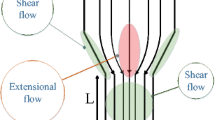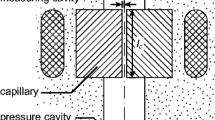Abstract.
A polytetrafluoroethylene(PTFE) capillary Ubbelohde viscometer was designed and constructed. The relative viscosities of aqueous solutions of a polyethylene oxide and a polyvinylpyrrolidone sample were carefully determined down to an extremely dilute concentration region. In comparison with the data obtained from the common glass capillary viscometer, slippage is believed to occur in the PTFE capillary due to its hydrophobic nature. While for the glass capillary viscometer, conventional viscous flow is operative and adsorption phenomena occur since both the solvent water and aqueous solution are wet and/or adsorbed onto the glass capillary surface due to the existence of hydroxyl groups on glass surface. The data were analyzed with a recently developed wall-effect theory and satisfactory results were obtained.



Similar content being viewed by others
References
Liu M, Cheng R, Qian R (1997) J Polym Sci Part B:Polym Phys 35:2424
Cheng R (1997) Polymers and organic solids. Science Press, Beijing, p.69
Cheng R, Shao Y, Liu M, Lu R (1998) Eur Polym J 34:1613
Yang Y, Yan X, Cheng R (1999) J Macromol Sci Phys 38:237
Cheng R, Yang Y, Yan X (1999) Polymer 40:3773
Cheng R. Shao Y, Liu M, Lu R (1999) Chin J Polym Sci 17(1):27
Cai J, Bo S, Yan X, Qin W, Cheng R (2001) Chin J Appl Polym Sci 18(5):377
Pan Y, Cheng R (2000) Chin J Polym Sci 18(1):57
Dondos A, Papanagopoulos D (1995) Polymer 36:365
Dondos A, Papanagopoulos D (1993) Makromol Chem Rapid Commun 14:7
Dondos A, Tsitsilianis C, Staikos G (1989) Polymer 30:1690
Papanagopoulos D, Dondos A (1996) Polymer 37:1053
Papanagopoulos D, Dondos A (1994) Macromol Chem Phys 195:439
Cheng R, Yan X (1991) J Appl Polym Sci Appl Polym Symp 48:123
Cheng R (1997) Macromol Symp 124: 27
Liu M, Cheng R, Qian R (1995) J Polym Sci Part B:Polym Phys 33:1731
Qian R (1982) In: Benoit H, Remp P (eds) Macromolecules. Pergamon Press, New York, p 159
Qian R, Cao T, Chen S, Bai F (1983) Chin Sci Part B 12:1080
Wu C (1994) J Polym Sci Part B:Polym Phys 32:1503
Ohrn OE (1955) J Polym Sci 17:137
Ohrn OE (1956) J Polym Sci 19:199
Ohrn OE (1958) Arkiv Kemi 12:397
Oene HV, Cragg LH (1961) Nature 191:1160
Oene HV, Cragg LH (1962) Nature 196: 1197
Cragg LH, Bigelow CC (1975) J Polym Sci 24:429
Cheng R, Bo S, Cai J, Qin W (2001) Chinese patent application number:01117757.8(2001.5)
Craubner VH (1964) Makromol Chem 78:121
Craubner VH (1965) Makromol Chem 89:105
Acknowledgements.
The authors thank the National Key Projects for Fundamental Research, "Macromolecular Condensed State", the State Science and Technology Commission of China, and the Natural Science Foundation of GuangDong Province of China, the State Key Laboratory of Polymer Physics and Chemistry of China, the National Natural Scientific Funds, and Specialized Research Fund for the Doctoral Program of Higher Education of China (2000028404) for funding .
Author information
Authors and Affiliations
Corresponding author
Rights and permissions
About this article
Cite this article
Cai, J., Bo, S. & Cheng, R. A polytetrafluoroethylene capillary viscometer. Colloid Polym Sci 282, 182–187 (2003). https://doi.org/10.1007/s00396-003-0904-3
Received:
Accepted:
Published:
Issue Date:
DOI: https://doi.org/10.1007/s00396-003-0904-3




